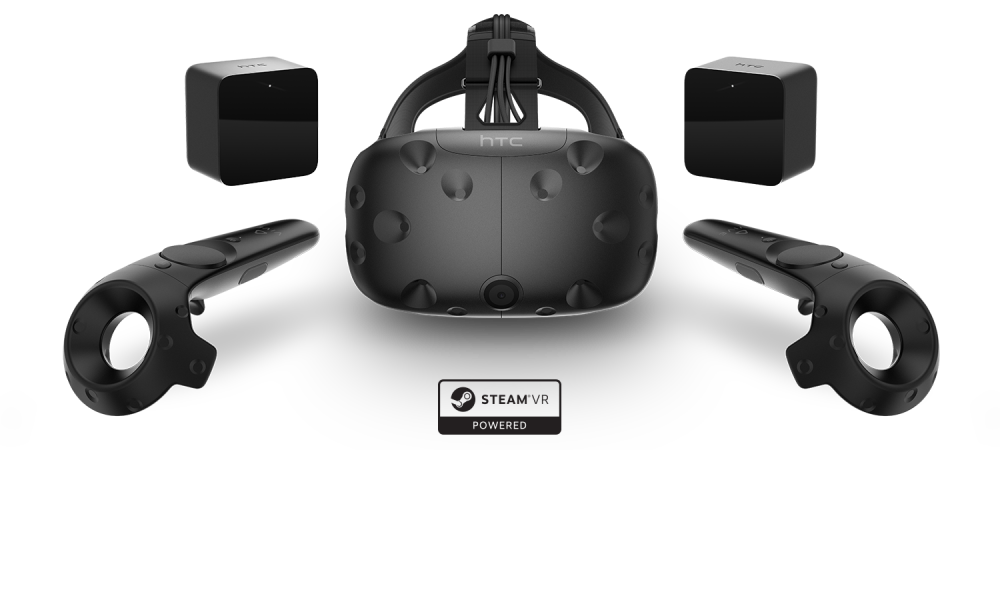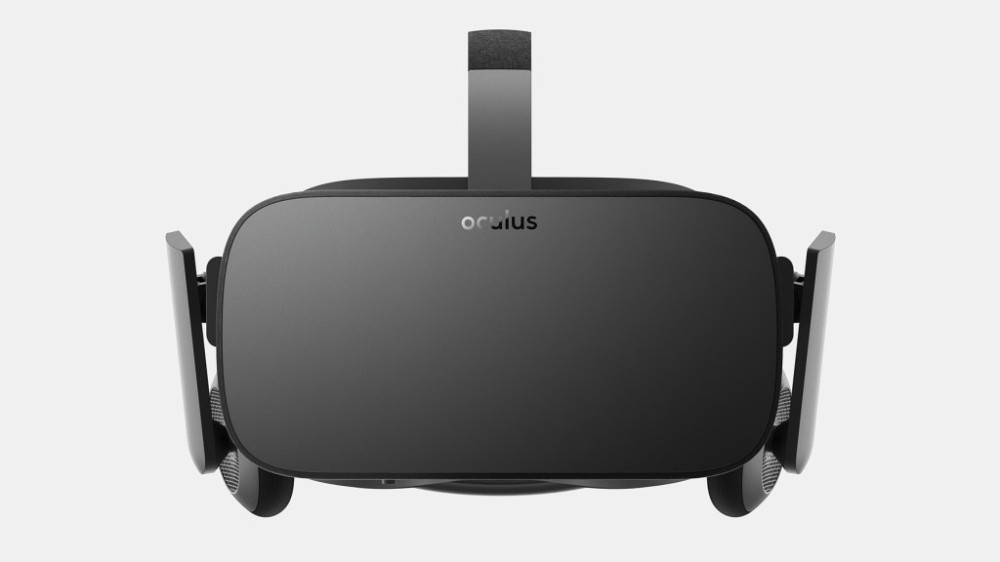Virtual reality has blown up these past couple years. It was envisioned and popularized in the past, however technology was limited. This led to the loss of popular interest. Now that there have been great advancements, VR has established itself as the new medium of interactive media. VR is one of the emerging technologies that I have great interest in. I remember when the Oculus Rift was in its Kickstarter phase and since then, the world of VR has blown up to provide extremely immersive experiences. There have been several iterations of the Oculus Rift, but a new contender has been recently released. The HTC Vive is the new big player in the VR arena and this product what I will discuss in this case study. I will be giving my opinion based on my research (reviews, videos, etc.) and not from actual hands-on experience because they are very expensive and I’m a broke college student.
About the HTC Vive
The HTC Vive is a VR device created through the collaboration the Valve corporation and HTC. Valve had started prototyping VR headsets and wanted to do full room tracking but at the time didn’t think that they were commercially ready to release a VR headset. Around this time, the Oculus Rift was gaining popularity. This led to the idea of Valve working with Oculus together to pursue the new market. Oculus was later acquired by Facebook, and this led to Valve looking for other options.
On the other hand, HTC wanted to dive into the realm of VR because of it’s great potential. The company wanted to do something innovative and be more than a smartphone company. With their advanced concepts team, they came up with the vision of the Vive (originally named the Re Vive). Between augmented reality and VR, HTC decided to pursue VR, but not like the way Samsung did with their Gear VR headset. This eventually led to the meeting between HTC and Valve.
The agreement was then locked in and the prototyping began. The idea of full room motion capture was kept thanks to laser tracking technology. Both companies worked well together. Many prototypes were made and were passed between HTC and Valve’s teams to ensure a presentable and polished product. Even the developers were very passionate about the product and maintained integrity (by not leaking information) amongst their fellow teammates by being honest about any faults and mistakes being made in the development process.
The commercial version of the HTC Vive was released on April 5, 2016. There have been many reviews on the product-the majority of them being positive. This of course led to comparisons between the Vive and the Rift which I will discuss later.
Hardware

The Vive consists of a headset, two wireless controllers and two motion tracking sensors (as shown in the photo). The headset provides a great viewing space and high resolution inside for stunning visuals. On the outside are sensors to work with the motion trackers as well as a front facing camera to track what’s going on outside of the headset. The two wireless controllers are provided for gameplay and natural navigation. These have sensors on the outside as well for the motion trackers. The motion trackers themselves are to be placed on opposite sides of a room for full 360° tracking.
After setting up the motion trackers, the device is ready to go. Just keep in mind, that the Vive requires at minimum at high end graphics card and CPU. The price point starts at $799 but the consumer will receive everything that they need. Considering the requirements, it would cost around ~$1500 to experience virtual reality.
This device is so unique because it allows the users to use the full room to move around during their experience. This means the user can duck on move their entire body, and this would influence what goes on in the game. In other words, the users aren’t stuck on their chairs. This makes the experience feel much more natural and life-like. The controllers also add to this by providing an intuitive experience especially when used with games. They act as the “hands” for the virtual version of the user. The haptic feedback from the controller also allow for a realistic experience.
Software
The HTC Vive is compatible with Steam and is beginning to expand it’s collection of games as developers continue to create more content. This is very beneficial especially since the Vive is a Valve product. More developers will be able to submit their VR games for the Vive since it’s the flagship VR product on the Steam client. There will also be an API open to developers so that anyone can make content (even more than games) specifically for the Vive.
Against the Oculus Rift

The Oculus Rift is the main competition against the HTC Vive. It is cheaper at the price point of $499, however the Rift does not come with controllers. Since there are no sensors on the outside of the headset, it does not utilize full room tracking. There is also no front facing camera like the HTC Vive, but this isn’t too big of an issue since the Rift isn’t meant as a full room experience. Both headsets have padding and adjustability, however, the Vive is heavier than the Rift and this can add a certain amount of discomfort.
On the software side, the HTC Vive has more games thanks to it’s spotlight on Steam. The Vive also has a feature that allows the user to connect their phone through bluetooth so that they can see their notifications without having to take off the headset. In addition to this, the front facing camera allows the user to see what’s really in front of them like if they’re too close to a wall. These two features are very powerful design decisions because it encourages the user to keep the headset on and to not be interrupted in their immersive experience. It should be noted that the Oculus Rift is focusing on exclusive titles which will alienate some of the potential users. More consumer may lean towards the Vive since it’s more open source. One can argue that the direction the Oculus is taking with exclusive titles is similar to consoles. “Why should I buy this product in order to play one or two games that I’m interested in?” This could be a killer for Oculus, especially if the Vive will deliver very high fidelity, major titles.
Looking forward and changes I’d make
As the market for VR continues to grow, I hope to see VR utilized in much more than games. Already, I’ve seen examples of how VR can be used for education and other forms of entertainment. I hope the demand for this grows especially now since we have the technology to make it happen. Obviously, I’d also like for the price to drop so that it can be more affordable for the average consumer. The required specs to run the Oculus Rift and HTC Vive are quite high, but as time goes on, these requirements will become more affordable and this will result in greater attainability. I’m sure that many households will be home to these headsets once it becomes more affordable and useful for the “average” consumer.
As technology advances, I hope to see VR headsets become fully wireless. I realize that this may be detrimental in terms of performance due to lag. It’s apparent though that once a high performance VR headset is made wireless, then this will open up a lot more potential for content and games. Not being tethered to a computer and having completely free motion will make the experience much more natural. I’m sure there are designs being made already for large scale experiences. This means more trackers around the area and possibly attached to the body so that other points like feet would affect the experience.
This technology can be used for online classes to still maintain a “real” experience. In addition to the traditional lecture, the student (depending on the course) may be able to demonstrate their skills using the VR platform and this could possibly be done remotely. There is so much potential in this field and it can be done
Conclusion
It’s obvious that the HTC Vive was designed to be as immersive as possible. I’m sure the designers really emphasized on the idea of Virtual Reality and this has been proven through the innovations HTC and Valve brought to the table. The hardware allows for many developers and designers to create experiences that feel as real as possible. With the market still at it’s early stages, it’s only a matter of time until these devices become household names.
Sources:
http://www.engadget.com/2016/04/05/htc-vive-review/
http://www.theverge.com/a/virtual-reality/oral_history
http://www.engadget.com/2016/03/18/htc-vive-an-oral-history/
http://www.wareable.com/vr/htc-vive-vr-headset-release-date-price-specs-7929